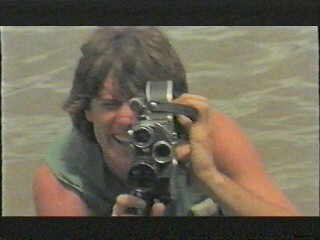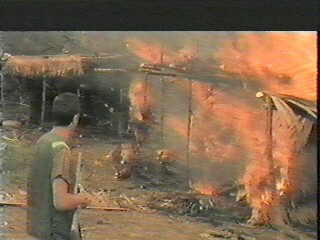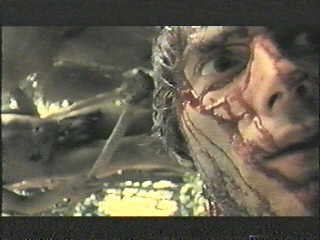Cannibal Holocaust

Well, I finally saw this film on Thursday, after a month of eager anticipation. I had been curious to see this notorious film since it resurfaced in the wake of the
Blair Witch Project’s release. It’s another one of those films, like
Battle Royale, whose reputation precedes it, stoked by the controversy surrounding it’s release, as well as on-line rumor and half-rememberd midnight screenings. Let’s just say that I was taken aback by what I actually saw, as I thought I was going to see a more realistic, yet still over the top, exploitation bloodbath. What was most surprising was that a film called
Cannibal Holocaust, supposedly the pinnacle film of the Italian cannibal genre (I have not seen any other examples of this genre, so I’m forced to go on hearsay), had such an intellectual contempt for its’s audience, though it still delivers the mondo thrills to anyone who would find such material “entertaining”. Through their film, director Ruggero Deodato and writer Gianfranco Clerici, outright condemns anyone who would want to watch such footage for entertainment purposes (to the point of half-heartedly operating under the pretense that the footage is real, just to hook in the curious) , while also critiquing the idea of documentary responsibility through the actions of the “victimized” documentary film-crew (all Americans from NYC, three men and one woman), who are more like Robert Flaherty-as-Satan than intrepid explorers.
First, to clear up some popular misconceptions about the film. It really is not all that gory, though what is shown is done so in a fairly realistic way (in fact, several animals which were depicted as being slaughtered in the film, were killed in reality); much of the actual mutilation, dismemberment, and cannibalism is shown, for the most part, from a distance, in bouncy, obscured, often out of focus shots. What is most stomach churning about the film is the extremely graphic, brutally realistic scenes of sexual violence against women (these scenes shut up the giggling stoners in the audience right away); the film includes a trio of rape scenes, as well as displaying the aftermath of sexual torture against a native woman (who may or may not have been the same native woman that the male members of the documentary crew gang raped in an earlier scene, I could not tell), who is shown skewered on a pole.
Secondly, the film is not compromised of all found footage, as was implied when people used the example of
Cannibal Holocaust to debunk the
Blair Witch Project rather novel stylistic approach. We are initially introduced to the four American filmmakers, as well as their jungle guide, via a television news report, which segues into an American interview show. It seems that the filmmakers had been missing for some time now, and NYU anthropology professor, Dr. Harold Monroe (Robert Kerman, who apparently starred in several cannibal films, as well as many pornos) is leading an expedition into Amazonia (or as the film typically refers to jungle, “the green inferno”) to find out what happened. The first half of the film is a fairly stylistically standard film, as Monroe is led into the jungle by his two guides, as well as a captive native from one of the more peaceful tribes. Signs of the initial expeditions disaster are every where (the worm-infested skeletal remains of the guide Felipe, natives wearing Western trinkets and practicing ritual cannibalism to drive out evil spirits, a burned out village full of fearful natives) but it is not until Monroe meets and befriends the cannibal tribe known as the Tree People that he finds what remains of the film crew: bones, tattered clothing, and film equipment. Monroe bargains with the Tree People Chieftain, who thinks Monroe is a powerful sorcerer because of his tape recorder, for the remaining film canisters, which hang as decoration in the Tree People village, and then seals the deal by partaking in a little human flesh.
From there, the film returns to New York City, where Monroe is in negotiations with some network executives to turn the found footage, which has yet to be processed or screened, into a potential television documentary. From there, Monroe’s positive preconceptions about the filmmakers, led by director Alan Yates, begins to unravel; first, through some man-on-the-street interviews with the filmmakers surviving relatives, many of whom have mixed feelings, to say the least, about their dearly departed, and then during a screening of one of Yates’s earlier films, a documentary about revolution in Africa. We learn from a nonplussed network executive that Yates typically staged the outlandish or violent scenes in his films, in this case, hiring soldiers to execute civilians as rebels (thus the film again blurs the boundaries between fiction and documentary). Then the screening of the found footage begins (some of which is silent). We see the television interviews which opened the film from the perspective of the filmmakers own hand-held cameras, and begin to see a more detailed picture of the filmmakers: cocky, arrogant, assholes, who would just as soon point a gun at somebody as they would a camera. In fact, a lot of their hijincks makes the trio of men come off like a bunch of out of control, horny frat boys. The footage, which is often overlaid with the film’s late 70s synth soundtrack (which comes in two varieties, incongruously mellow and portentous), becomes progressively more disturbing, as the filmmakers seem to document just about every step of their journey. Disaster first strikes when their guide puts on his boots and is bitten by a poisonous snake; the filmmakers attempt to save his life by amputating his leg (in close-up) with a machete, but they fail, and the filmmakers press on.

When they reach the first native village, they use their rifles to scare the natives, shooting into the air, the scrambling crowd of villagers, and the native’s livestock. The filmmakers desperately want to document a Tree People attack, so they herd the terrified villagers, mainly women and children, into their thatched huts, and set them afire, while keeping the villagers in the huts with their guns just so they can watch them cry out and burn to death, filming the resulting confusion and atrocity so that it can be edited together in the future. After the massacre, Alan and his girlfriend Fay fuck, rutting like animals on the ruins of a native hut, while the remaining villagers cower fearfully in the background; when Alan notices that his friends are filming him, he sheepishly tries to ward them off, but luxuriates in the moment.
The film makes no bones about it, the American filmmakers are truly despicable people, and Monroe, taking a break from watching the footage, has a crisis of conscience, and refuses to participate further in the documentary film project on moral grounds. When the network executives balk at his protests, Monroe challenges them to watch the remainder of the footage with him, and they agree, sequestering themselves off to a private screening room to watch the remaining footage. What follows is perhaps the most disturbing part of the film, as the filmmakers come upon a naked woman, a member of the Tree People tribe, and run her down, tackling her, pinning the struggling woman to the muddy ground, and taking turns raping her while the others capture the moment for posterity on film (only Fay objects, and she is casually pushed away by Alan). During the final screening of the found footage, Deodato repeatedly cuts away from the on-screen violence, to the network executives, who increasingly look ashen and askance at the unfolding carnage, looking increasingly sick at the prospect that this footage could every clearly be seen as “entertainment,” and thus I think they are supposed to act as surrogates for the actual
Cannibal Holocaust audience. It’s unfortunate for them that their exploits are seen by Tree People warrior who hides in the overgrowth, but before their eventual comeuppance, they come upon the skewered woman (the wooden poll impales her through the vagina, and exits through her mouth) and Alan has the gall to say: “Oh, good Lord! It's unbelievable. It's horrible. I can't understand the reason for such cruelty. It probably has something to do with some bizarre sexual rage with the almost profound respect these primitives have for virginity.”

The screening ends with the final footage the crew shot, the attack of the Tree People. First one member of the crew is dragged away, castrated, and then torn apart while still alive. Like
The Blair Witch Project, you kind of have to wonder why they keep filming instead of running, but given the filmmakers maniacal search for authentic violence, as well as obvious delusion of what constitutes reality through the camera lens, it’s fairly understandable. Fay is the next victim, and she is dragged away by the Tree People screaming for help, repeatedly raped and then beaten to death. All of these scenes of carnage are seen in fragments, though the sound is fairly clear through; actually, you barely ever see a clear picture of the attackers, so I may be wrong, and the attackers may be a rival cannibal tribe, the Swamp People. The final shot from the camera is a close up of a dead Alan lying prone on the ground, the camera clearly lying on the ground next to him, his eyes glazed and vacant, blood streaming down the side of his face. When the final frames flicker through the projector, the lights come up, and horrified executives immediately order all the footage destroyed. A satisfied Monroe exits the network’s lower Manhattan offices, musing to himself who the real savages are in voice-over, as he walks down the street. An end title appears on screen, informing the audience that the projectionist was convicted of stealing and selling the presumably real footage.
Needless to say , my viewing of
Cannibal Holocaust was not the Halloween fun and games I had expected, but instead a sobering, intellectual look at the complicity and responsibility of the bloodthirsty, exploitation audience in the filmmed violence they devour (though I hazard to say it, since I haven’t seen the film in question,
Cannibal Holocaust seems to me to be in the vein of Haneke’s
Funny Games). I think it is clear that Monroe’s final verdict is supposed to apply to the audience, and this was one of the reasons that Deodato and Clerici used the found footage motif, to increasingly blur the line between fiction and reality. One would have to ask: If no one would find this material “entertaining” in real life, why is it so when done via fiction?


0 Comments:
Post a Comment
Subscribe to Post Comments [Atom]
<< Home